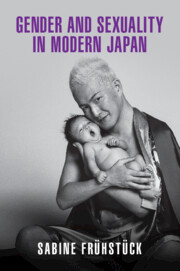Book contents
- Gender and Sexuality in Modern Japan
- New Approaches to Asian History
- Gender and Sexuality in Modern Japan
- Copyright page
- Contents
- Figures
- Acknowledgments
- Introduction
- 1 Building the Nation and Modern Manhood
- 2 Controlling Reproduction and Motherhood
- 3 Redefining Womanhoods
- 4 Sex at War
- 5 The Politics of Sexual Labor
- 6 Queer Identities and Activisms
- 7 Sexing Visual Culture
- 8 Epilogue
- Bibliography
- Index
- New Approaches to Asian History
2 - Controlling Reproduction and Motherhood
Published online by Cambridge University Press: 24 March 2022
- Gender and Sexuality in Modern Japan
- New Approaches to Asian History
- Gender and Sexuality in Modern Japan
- Copyright page
- Contents
- Figures
- Acknowledgments
- Introduction
- 1 Building the Nation and Modern Manhood
- 2 Controlling Reproduction and Motherhood
- 3 Redefining Womanhoods
- 4 Sex at War
- 5 The Politics of Sexual Labor
- 6 Queer Identities and Activisms
- 7 Sexing Visual Culture
- 8 Epilogue
- Bibliography
- Index
- New Approaches to Asian History
Summary
In the 1870s and 1880s, some of Japan’s leading intellectuals and modernizers discussed human rights, reintroduced the binary difference between male and female, and declared motherhood the core principle of women’s nature. As gender displaced status as the primary system of social and legal classification, women began adopting the language of rights and representing themselves in public. By the beginning of the twentieth century, women forcefully entered and shaped a range of debates. Chapter 2, “Controlling Reproduction and Motherhood,” discusses women’s struggle to both define motherhood for themselves and take control of reproduction – the debate about motherhood being closely tied to the quest for legalizing abortions. Notably, this demand was increasingly at odds with the country’s advancing imperialism, which relied on rapid population growth. The end of the Japanese empire constituted a major rupture within the question of reproductive control, ultimately leading to today’s effects of rapid population decline and the lack of will among the young generation to have babies.
Keywords
- Type
- Chapter
- Information
- Gender and Sexuality in Modern Japan , pp. 47 - 69Publisher: Cambridge University PressPrint publication year: 2022

